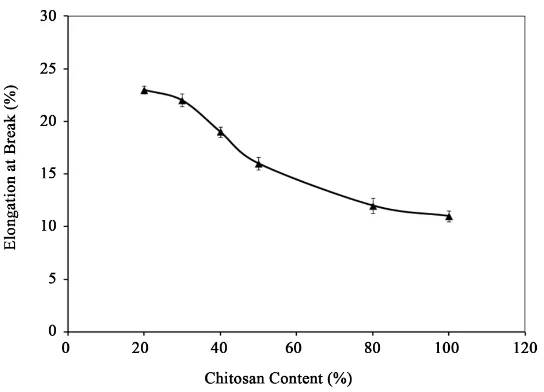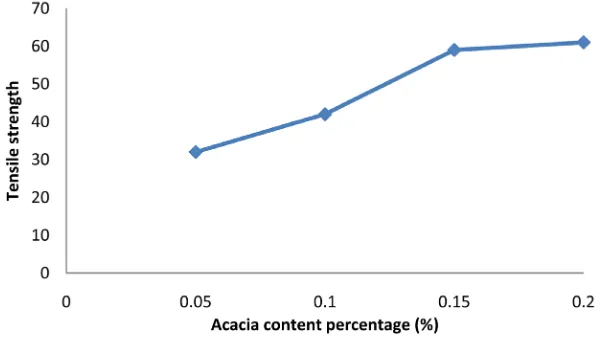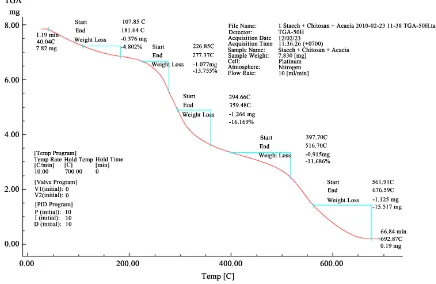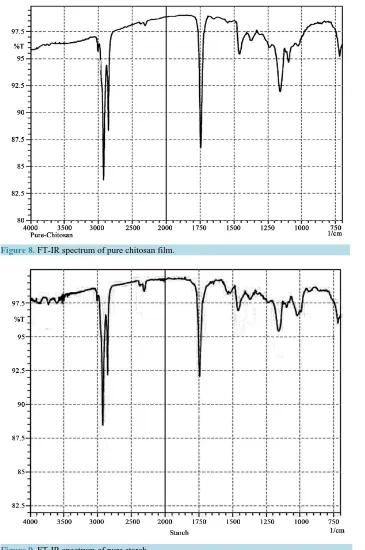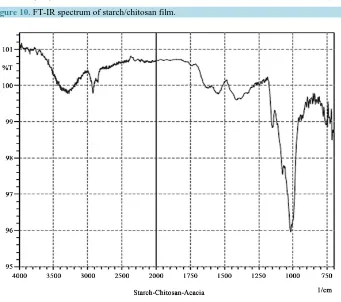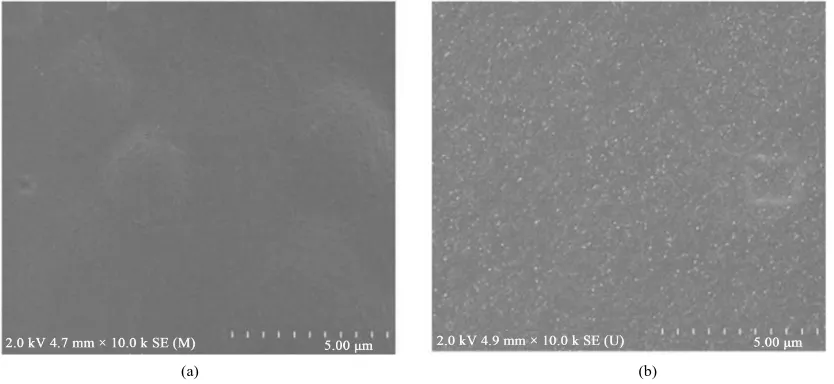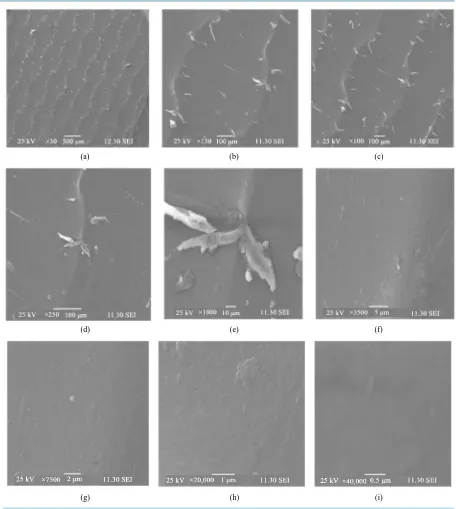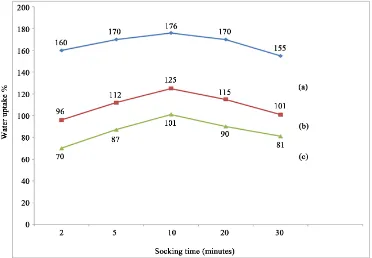http://dx.doi.org/10.4236/ojopm.2016.61002
How to cite this paper: Mollah, M.Z.I., Akter, N., Quader, F.B., Sultana, S. and Khan, R.A. (2016) Biodegradable Colour Po-lymeric Film (Starch-Chitosan) Development: Characterization for Packaging Materials. Open Journal of Organic Polymer Materials, 6, 11-24. http://dx.doi.org/10.4236/ojopm.2016.61002
Biodegradable Colour Polymeric Film
(Starch-Chitosan) Development:
Characterization for Packaging Materials
M. Z. I. Mollah1*, N. Akter2, F. B. Quader2, S. Sultana1, R. A. Khan1
1Nuclear and Radiation Chemistry Division, Institute of Nuclear Science and Technology, Bangladesh Atomic Energy Commission, Dhaka, Bangladesh
2Department of Applied Chemistry and Chemical Engineering, University of Dhaka, Dhaka, Bangladesh
Received 13 December 2015; accepted 8 January 2016; published 12 January 2016
Copyright © 2016 by authors and Scientific Research Publishing Inc.
This work is licensed under the Creative Commons Attribution International License (CC BY). http://creativecommons.org/licenses/by/4.0/
Abstract
Biodegradable starch-based chitosan reinforced composite polymeric films were prepared by casting. The chitosan content in the films was varied from 20% to 80% (w/w). Tensile strength (TS) was improved significantly with the addition of chitosan but elongation at break (EB %) of the composites decreased. Tensile strength of the composites raised more with the addition of the acacia catechu content in the films varied from 0.05% to 0.2% (w/w). The better thermal stability of this prepared film was confirmed by thermo-gravimetric analysis. Structural characterization was done by Fourier transform infrared spectroscopy. Surface morphologies of the composites were examined by scanning electron microscope (SEM) which suggested sufficient homogeniza-tion of starch, chitosan and acacia catechu. Water uptake was found lower for final composites in comparison to starch/chitosan and chitosan films. The satisfactory rate of degradation in the soil is expected that the final composite film is within less than 6 months. The developed films in-tended to use as the alternative of synthetic non-biodegradable colored packaging films.
Keywords
Chitosan, Starch, Acacia Catechu, Composite, Biodegradable, Packaging
1. Introduction
Generally, plastic products are derived from non-renewable fossil fuels and are non-biodegradable [1] [2]. The
production of plastic materials has been increasing considerably due to the extensive growth of the world popu-lation. The improper disposal of the enormous volume of petroleum-derived plastics leads to environmental pollution and raises the question—how to replace them with natural polymers, being biodegradable and renewa-ble resources [3]. Biological recycling of polymers must be considered as an alternative to more traditional re-cycling procedures and this has stimulated researchers to synthesize new polymers that can be returned to the biological cycle after use. Therefore the use of agricultural biopolymers that are easily biodegradable would solve these problems [4]. Over the last decade, the interest in biodegradable films and films-made packaging materials from renewable and natural polymers has increased. Recently, scientists have devoted much energy to developing novel biodegradable hydrogels material for drug delivery [5], tissue engineering [6], sensors [7], contact lenses [8], purification [9], etc.
For coloring film a natural resin Khair (Acacia catechu) is used. Khair is a moderate size deciduous tree with rough dark gray brown bark. It belongs to family Leguminoseae-mimoseae. The most important product ob-tained from Acacia catechu var. catechu proper is Khair or catechu. This is obtained by boiling chips of heart-wood with water in specially designed earthen pitchers and allowing the concentrate to cool and crystallize. As sold in local market, catechu is found in irregular pieces or small square blocks of grayish black color, which on breaking show a crystalline fracture [10]. Catechin oxygenase, a key enzyme in the degradation of catechin, is present in fungi and bacteria [11]. Color of catechu-water solution is dark brown. This solution is acidic in na-ture. The chief chemical constituent of catechu is catechin. Catechin is polyphenolic antioxidant plant secondary metabolite. Catechin possesses two benzene rings (called the A- and B-rings) and a dihydropyranheterocycle (the C-ring) with a hydroxyl group on carbon 3. The A ring is similar to a resorcinol moiety while the B ring is similar to a catechol moiety. There are two chiral centers on the molecule on carbons 2 and 3. It has therefore four diastereoisomers. Two of the isomers are in trans-configuration, called catechin and the other two are in cis-configuration, called epicatechin [12].
Chitin is the second most abundant natural polymeric material. It is a linear polysaccharide composed of 2-ace-tamido-2-deoxy-D-glucosidic bonds. Conversely, chitosan is an amino polysaccharide comprising an un-branched chain of β (1 → 4)2-amino-2-deoxy-D glucopyranose residue. Chitosan has been extensively studied in pharmaceutical and medical fields for its biodegradability, biocompatibility, bioactivity, and interesting phy-sicochemical properties partially acetylated chitosan having about 50% D-glucosamine unit which is only able to dissolve in water [12]. This biopolymer is bio-renewable, biodegradable, and bio-functional. The presence of active groups in chitosan molecules favored it to use chitosan in many fields. Chitosan films are now used in making biodegradable packaging material. Several studies have indicated the bacteriostatic [13]-[17] and fun-gistatic [18] activities of Chitosan. Because of reactive amino and hydroxyl functional groups, chitosan is fre-quently blended with other polymers [19]. Starch and chitosan are hydrocolloids with well-known good film forming capacities. Both have been reported as potential materials for packaging [20].
Starch, a natural renewable polysaccharide from a great variety of crops, is one of the promising raw materials for the production of biodegradable plastics because of its low cost, availability as a renewable resource, biode-gradable and the innocuous degradation products. It has already been widely researched as an important raw material for environmental and biomedical applications. Starch is a carbohydrate consisting of a large number of glucose units joined together by glycosidic bonds. It consists of two types of molecules: the linear and helical amylose and the branched amylopectin [12]. But pure starch based materials are hydrophilic and their mechani-cal properties decrease with the water intake [21] [22]. To overcome this behavior, starch can be blended with other polymeric material [23] like chitosan. The application of pure starch films is extremely limited due to the high hydrophilicity and deficient mechanical properties of starch [24] [25].
The objective of the present research was developing colored films based on starch and chitosan by using acacia catechu. The mechanical properties of the prepared films were measured. Molecular interactions of com-ponents present in films were examined by Fourier Transform Infrared (FT-IR) spectroscopy. Thermal proper-ties of the films were investigated by Differential Scanning Calorimetric (DSC) studies. Surface topography of the films was investigated by Scanning Electron Microscopy (SEM). The water uptake and the degradation test in soil were also performed.
2. Materials and Methods
2.1. Materials
GmbH, Germany. Acacia catechu bought from the local market of Bangladesh. The chemical formulas of chito-san, starch and acacia catechu,Figure 1.
2.2. Preparation of Biopolymeric Films by Casting
Solution of 1% chitosan (w/w) was made using 2% (w/w) acetic acid solution. The chitosan films were prepared by casting onto flat silicon-coated Petri dishes and allowed to dry for 24 h at room temperature with 35% rela-tive humidity. Dried films were peeled off manually using spatula and stored in the desiccators prior to charac-terization. Starch was dissolved in de-ionized hot (70˚C) water with constant stirring. Then starch and chitosan solutions were mixed together at different proportions. Composite films were prepared by solution casting at the same parameters (Figure 2). The water soluble Acacia catechu was mixed with the chitosan + starch solution at different proportions and the films are prepared by casting (Table 1& Table 2). Thickness of films was main-tained to 100 μm.
2.3. Mechanical Properties of the Films
[image:3.595.236.392.300.457.2]Mechanical properties like TS, Tm (tensile modulus), and Eb of the films were investigated by the Universal Testing Machine (Hounsfield series S testing machine, UK, H50 KS-0404) with a crosshead speed of 1 mms−1 at
Figure 1. Structure of (a) chitosan, (b) starch and (c) catechin.
Table 1. Formulations of chitosan/starch film.
Formulation Starch (%) Chitosan (%)
1 80 20
2 70 30
3 60 40
4 50 50
[image:3.595.90.539.625.719.2]5 20 80
Table 2. The formulations of starch + chitosan + acacia catechu film.
Acacia catechu concentration in film formulation (wt%)
Concentration (wt%) of film components after casting (in dry film)
Starch Chitosan Acacia catechu Total
0.05 47.62 47.62 4.76 100
0.1 45.46 45.46 9.08 100
0.15 43.48 43.48 13.04 100
Figure 2. Prepared biodegradable colour film.
a span distance of 25 mm. The dimensions of the test specimen were: 60 mm × 15 mm × 0.01 mm. The experi-ment was carried out according to the European standard (ISO/DIS 527-1:2010).
2.4. Thermal Properties Analysis of the Films
The thermo mechanical (TM) test of the films was taken using computer controlled Differential Scanning Calo-rimeter (Model: DSC-60 Supplier: Shimadzu Corp.). The temperature range was maintained at 30˚C to 500˚C and the temperature was increased at a rate of 10˚C/min. the flow rate of nitrogen gas was 20 ml/min. Sample weights were 7.82 mg.
2.5. Fourier Transform Infra Red (FTIR) Spectroscopy
FTIR spectra of the films were recorded using a Spectrum One spectrophotometer (Perkin-Elmer) equipped with an attenuated total reflectance (ATR) device for solids analysis and a high linearity lithium tantalate (HLLT) detector. Spectra were analyzed using the Spectrum 6.3.5 software. Films were stored at room temperature for 72 minutes in a desiccator containing saturated NaBr solution to ensure a stabilized atmosphere of 59.1% RH at 20˚C. Films were then placed onto a zinc selenide crystal, and the analysis was performed within the spectral re-gion of 650 - 4000 cm−1 with 16 scans recorded at a 4 cm−1 10 resolution. After attenuation of total reflectance and baseline correction, spectra were normalized with a limit ordinate of 1.5 absorbance units. Resulting FTIR spectra were compared in order to evaluate the effects of starch filling in the chitosan-based films, based on the intensity and shift of vibrational bands.
2.6. Scanning Electron Microscopy Analysis (SEM)
Film samples (5 × 5 mm) were deposited on an aluminum holder and sputtered with gold-platinum (coating thickness, 150 - 180 Å) in a Hummer IV sputter coater. SEM photographs were taken with a Hitachi S-4700 FEG-SEM scanning electron microscope (Hitachi Canada Ltd., Mississauga, ON, Canada) at a magnification of 40,000×, at room temperature. The working distance was maintained between 15.4 and 16.4 mm, and the acce-leration voltage used was 5 kV, with the electron beam directed to the surface at a 90˚ angle and a secondary electron imaging (SEI) detector.
2.7. Degradation Test
Degradation tests of the monomer grafted film were performed under humid soil at ambient condition. Up to three weeks of the tests were carried out. Films ware placed inside 10 cm depth of humid soil and at set time points, samples were taken out cleaned and kept inside desiccators prior to weighting. The formula employed was:
(
)
{
}
Weight loss % = Wb─Wa Wb×100
where, Wb = weight before placement in soil; Wa = weight after taken out and cleaned.
2.8. Statistical Analysis
multi-ple-range tests were used to perform statistical analysis of all results, using PASW Statistics Base 18 software (SPSS Inc., Chicago, IL, USA). Differences between means were considered to be significant when p≤ 0.05.
3. Results and Discussion
3.1. Mechanical Properties of Chitosan Reinforced Starch-Based Composite Films
Chitosan (20% - 80% w/w) was added in starch-based films to investigate the effectiveness of chitosan as rein-forcing filler. Tensile strength (TS) values of starch-based films was improved significantly (p ≤ 0.05) with the addition of chitosan. Figure 3shows the effect of chitosan on TS values of starch-based films. For 20%, 30%, 40%, 50% and 80% addition of chitosan, the TS values were observed to be 27, 30, 38, 47, and 53 MPa, respec-tively. The starch-based films became brittle below 20% chitosan content. So, in this investigation, the minimum amount of chitosan was maintained to 20% (by wt). It may be mentioned here that only starch could not form films by solution casting. The TS of chitosan films was found to be 56 MPa (denoted 100% chitosan in Figure 3). The 50% chitosan content starch-based films were almost transparent but below 50% chitosan containing films was opaque in nature.
[image:5.595.182.448.302.482.2]With the rise of strength and modulus, the Eb values of the starch-based films decreased monotonously due to chitosan addition (Figure 4). The Eb values of 20%, 30%, 40%, 50%, and 80% chitosan content films were
Figure 3. Effect of chitosan on tensile strength of starch-based film.
[image:5.595.180.452.507.703.2]23%, 22%, 19%, 16%, and 12%, respectively. Chitosan acted as a reinforcing agent in starch-based biodegrada-ble films. Thus, higher content of chitosan can render the films stiffer. As a result, decrease in Eb values was observed. Similar results were reported by Pinotti et al.[26] who indicated the reduction in methylcellulose (MC) film flexibility with increasing chitosan concentration. Khan et al.[27] reported that chitosan incorporation (5% - 36% by wt) in methylcellulose-based films significantly improved the strength of the films with the reduction of viscoelasticity. The 50% chitosan containing starch-based films was considered as the optimum because the films had good strength (47 MPa) and modulus (550 MPa) and optimum Eb (16%) values. Moreover, the ap-pearance of the films was quite transparent.
3.2. Effect of Acacia Catechu on Mechanical Properties of Starch/Chitosan Film
[image:6.595.163.469.343.513.2]Tensile strength (TS) values of chitosan/starch-based films were improved significantly with the addition of acacia catechu. Because Acacia Catechu is natural colored resin, like other natural resin it enhances mechanical properties of the film. Figure 5 shows the effect of Acacia Catechu on TS values of starch-based films. For 0.05%, 0.1%, 0.15%, 0.2% of addition of acacia catechu, the TS values were observed to be 35, 45, 60, 62 MPa respectively. The acacia catechu + starch + chitosan based films became brittle over 0.2% acacia catechu content. So, in this investigation, the maximum amount of acacia catechu was maintained to 0.2% (w/w).
[image:6.595.164.477.541.706.2]Figure 6 shows with the rise of strength, the elongation at break values of the acacia catechu + starch + chi-tosan based films decreased monotonously due to the acacia catechu addition. The Eb values of 0.05, 0.10, 0.15, 0.2 (wt%) of addition of acacia catechu the composite films were 22, 19, 13, and 12 respectively. Acacia catechu acted as a reinforcing agent in chitosan/starch-based biodegradable films.
Figure 5. Effect ofacacia catechu ontensile strength of starch-chitosan based films.
3.3. Thermal Property of Starch + Chitosan + Acacia Catechu Film
The thermo gravimetric analysis (TGA) for starch + chitosan + acacia catechu showed inFigure 7. In this expe-riment, weight of the film (starch + chitosan + acacia catechu) was taken 7.82 mg. the TGA data for starch + chitosan + acacia catechu showed two steps in weight loss: one at 100˚C and another at 390˚C - 400˚C. Total weight loss at 107.85˚C, 226.85˚C, 294.66˚C, 397.70˚C, 561.91˚C is 4.802%, 13.755%, 16.169%, 11.686% and 15.17% respectively. At temperature between 120˚C - 130˚C high density poly ethylene degrades completely but this film (starch + chitosan + acacia catechu) at 359.70˚C degrades only 16.169%. So this biodegradable co-lored film in comparison with HDPE showed better thermal stability.
3.4. Fourier Transform Infrared Spectroscopic Analysis
The absorption peaks of the pure chitosan film (Figure 8) were mainly assignable to the stretching of intra and intermolecular O-H and -CH2OH vibrations at 3007 cm−1 overlapped with stretching -NH2 (2922 cm−1) and -NH
secondary amides vibrations (2852 cm−1). In addition, 2312 cm−1 corresponds to symmetric and asymmetric C-H vibrations. Amide I vibrational mode at 1745 cm−1 and Amide II at 1458 cm−1 were also clearly observed. The stretching C-N vibration appeared at 1238 cm−1 and stretching C-O band came at 1159 cm−1. Other peaks (from 1097, 1028 and 721 cm−1) appeared from water molecules present in chitosan.
The FT-IR spectrum of pure starch film is represented inFigure 9. The peak at 1157 cm−1 was found due to the C-O stretching of the C-OH group in starch. The characteristic peak at 1099 cm−1 and 1020 cm−1 were attri-buted to C-O stretching of the C-O-C group in the anhydroglucose ring. The peak frequencies at 3612, 3730 and 3857 cm−1 were attributed to O-H group stretching.
[image:7.595.93.529.420.704.2]The chitosan/starch-based film was investigated to find out the molecular interactions between chitosan and starch. The spectrum is represented in Figure 10 of starch-chitosan blend film. Both Amide I and Amide II peaks were not shifted. Both the peaks appeared at 1745 cm−1 and 1458 cm−1. The stretching C-N vibration ap-peared at 1236 cm−1 that was slightly lower than pure chitosan (1238 cm−1). On the other hand, the stretching C-O band came at 1161 cm−1 that was slightly higher than pure chitosan (1159 cm−1). The main characteristic
Figure 8. FT-IR spectrum of pure chitosan film.
Figure 9. FT-IR spectrum of pure starch.
peak (1099 cm−1) of starch (C-O stretching from C-O-C group) was not shifted. From this spectrum, this is clearly revealed that chitosan was not chemically reacted with starch, as expected. Here, a bio-blend was formed between chitosan and starch.
Figure 10. FT-IR spectrum of starch/chitosan film.
Figure 11. FT-IR spectrum of acacia catechu/starch/chitosan film.
cm−1 Acacia catechu might be reacted with amide group of chitosan or may be hydrogen bond formed. The ab-sorption peaks (3302 cm−1 and 2872 cm−1) of the starch + chitosan + acacia catechu film found broader than the absorption peaks of the pure chitosan film assignable to the stretching of intra and intermolecular O-H and -CH2OH vibrations at 3007 cm−1 overlapped with stretching -NH2 (2922 cm−1) and -NH secondary amides
[image:9.595.145.486.320.622.2]3.5. Morphological Study by Using Scanning Electron Microscope (SEM)
Figure 12 represents the surface morphology of chitosan (a), and chitosan reinforced starch-based films (b). The surface of chitosan films appeared a homogenous, smoother and denser film surface with no gross defects. The smooth and homogenous surface of the films is an indicator of the structural integrity of the observed films, and thus good mechanical properties were obtained. It also indicated better solubilization and homogenization of chitosan in aqueous medium. But chitosan reinforced starch-based films showed rough and irregular surface with bubbles as compared to pure chitosan films.
3.6. Surface Morphology of the Final Starch + Chitosan + Acacia Catechu Films
The surfaces of the Acacia Catechu (0.15% by wt) containing chitosan/starch (50:50)-based films were investi-gated by scanning electron microscopy (SEM) from low to high magnification. The images are presented in
Figures 13(a)-(i). In open eye, the surface of the films was very clear, homogeneous, and shiny. But at × 30 magnifications (a), phase separation is clearly shown which indicated that chitosan/starch (biopolymers) and acacia catechu (natural resin) did not react with each other, as expected. Natural resin was added to improve the mechanical strength and to make the film bioactive to protect the packaged food against bacteria. At medium magnification (×50, and ×100), represented by (b) and (c), phase separation is more clearly visible.
With the rise of magnification from ×250 to ×1000; Figures 13(d)-(f), few defects are found and surfaces look heterogeneous. Dramatic image is observed at ×3500 magnification (f). Here surface is cleaner and ap-pearance is much better than other low magnification images.
At very high magnifications from ×7500 to ×40,000; Figures 13(g)-(i), surfaces of the films look much better. At ×40,000 magnifications (i) the SEM image of the film is fantastic and indicated more homogeneity. Films are clear from bubbles and irregularities. From this image, it is concluded that a homogeneous film surface appeared using three natural materials. Two biopolymers (chitosan and starch) and one natural resin (acacia catechu) mixed homogeneously and made a fantastic bio-blend for the preparation of biodegradable film for food pack-aging application.
3.7. Water Uptake
The water uptake behavior of chitosan film and chitosan (50% by wt) reinforced starch-based composite films are shown in Figure 14. It was found that water uptake of starch/chitosan composite films were much lower compared to native chitosan films. Both type of films absorbed water very rapidly. After 2 min, chitosan film absorbed 160% water, whereas the starch/chitosan film absorbed 96% water. At 10 min, chitosan reached to 176% and starch/chitosan arrived at 125% of water uptake then both the films showed a gradual decrease of water up-take and indicated the loss of its mass. After 30 min, the water upup-take of chitosan and starch/chitosan films
(a) (b)
(a) (b) (c)
(d) (e) (f)
[image:11.595.84.540.77.586.2](g) (h) (i)
Figure 13. Surface morphology of starch + chitosan + acacia catechu film.
films in aqueous medium.
But films with acacia catechu were almost static. After 30 min, the water uptake of acacia catechu (0.15 wt%) + starch + chitosan based film, native chitosan and starch/chitosan films reached to 81%, 155%, and 101%.
Acacia catechu (0.15 wt%) + starch + chitosan based film had better stability in water compared to chitosan or chitosan/starch-based films. Acacia catechu might be create a network with the biopolymers (chitosan and starch) and formed network, which prevented water molecules penetration into the films.
3.8. Soil Degradation Test
[image:12.595.129.501.224.482.2]In Figure 15, weight loss (%) was plotted against the degradation time is soil (week). It was observe that the weight loss (%) is increased with the increasing time. After one week, weight loss is 0.2%, after two weeks,
Figure 14. Water uptake ofpurechitosan film (a), chitosan/starch film (b) and acacia catechu (0.15%) + starch + chitosan (c) film.
[image:12.595.144.493.520.704.2]weight loss is 0.5%, after three weeks, weight loss is 3%, after four weeks, weight loss is 5%. From this investi-gation, it was expected that this film will be biodegradable in soil in less than 6 months. Moreover, in the pre-pared films, Acacia catechu, starch and chitosan, all are natural fiber and totally biodegradable. So, the film did not lose its total inherent biodegradable character after mixing but withstand its stability for longer period.
4. Conclusion
Biodegradable film made of starch, chitosan and acacia catechu was successfully developed by solution casting. The key factor of the blend polymer is H-bonding with two polymers. Acacia catechu contributed to the im-provement of tensile strength in starch/chitosan films. This film showed good thermal stability also. Structural characterization was done by FT-IR. The surface morphologies indicated better homogenization of the three biopolymers (starch, chitosan and acacia catechu). Water update was lower for acacia catechu incorporated film than starch/chitosan film. Finally, degradation rate in soil is satisfactory also. The prepared films can be used as the colored bio-degradable packaging films.
References
[1] Pagella, C., Spigno, G. and De Faveri, D.M. (2002) Characterization of Starch Based Edible Coatings. Food and Bio-products Processing, 80, 193-198. http://dx.doi.org/10.1205/096030802760309214
[2] Ban, W.P., Song, J.G., Argyropoulos, D.S. and Lucia, L.A. (2006) Influence of Natural Biomaterials on the Elastic Properties of Starch-Derived Films: An Optimization Study. Industrial & Engineering Chemistry Research, 45, 627- 633. http://pubs.acs.org/doi/abs/10.1021/ie050219s
[3] Daia, H., Changb, P.R., Yua, J. and Maa, X. (2008) N,N-Bis(2-hydroxyethyl)formamide as a New Plasticizer for Thermoplastic Starch. Starch/Stärke, 60, 676-684. http://dx.doi.org/10.1002/star.200800017
[4] Parra, D.F., Tadini, C.C., Ponce, P. and Lugão, A.B. (2004) Mechanical Properties and Water Vapor Transmission in Some Blends of Cassava Starch Edible Films. Carbohydrate Polymers, 58, 475-481.
http://dx.doi.org/10.1016/j.carbpol.2004.08.021
[5] Wu, D., Wang, T., Lu, B., Xu, X., Cheng, S. and Jiang, X. (2008) Fabrication of Supramolecular Hydrogels for Drug Delivery and Stem Cell Encapsulation. Langmuir, 24, 10306-10312. http://dx.doi.org/10.1021/la8006876
[6] Khan, F., Tare, R., Richard, O., Oreffo, R. and Bradley, M. (2009) Versatile Biocompatible Polymer Hydrogels: Scaf-folds for Cell Growth. Angewandte Chemie International Edition in English, 48, 978-982.
http://dx.doi.org/10.1002/anie.200804096
[7] Sorber, J., Steiner, G., Schulz, V., Guenther, M., Gerlach, G. and Salzer, R. (2008) Hydrogel-Based Piezoresistive pH Sensors: Investigations Using FT-IR Attenuated Total Reflection Spectroscopic Imaging. Analytical Chemistry, 80, 2957-2962. http://dx.doi.org/10.1021/ac702598n
[8] Katsoulos, C., Karageorgiadis, L., Vasileiou, N., Mousafeiropoulos, T. and Asimellis, G. (2009) Customized Hydrogel Contact Lenses for Keratoconus Incorporating Correction for Vertical Coma Aberration. Ophthalmic and Physiologi-cal Optics, 29, 321-329. http://dx.doi.org/10.1111/j.1475-1313.2009.00645.x
[9] Ha, E.J., Kim, Y.J., An, S.S.A., Kim, Y.K., Lee, J.O. and Lee, S.G. (2008) Purification of His-Tagged Protein Using Ni2+-Poly(2-acetamidoacrylic Acid) Hydrogel. Journal of Chromatography B, 876, 8-12.
http://dx.doi.org/10.1016/j.jchromb.2008.10.020
[10] Indian Council of Forestry Research and Education (2010) Dehradun. Khair (Acacia catechu). Dehradun, Forest Re-search Institute. http://www.frienvis.nic.in/WriteReadData/UserFiles/file/pdfs/Khair.pdf
[11] Arunachalam, M., Mohan Raj, M., Mohan, N. and Mahadevan, A. (2003) Biodegradation of Catechin. Proceedings of the Indian National Science Academy, 69, 353-370.
http://www.new1.dli.ernet.in/data1/upload/insa/INSA_1/20008a2f_353.pdf
[12] The Wikipedia. http://en.wikipedia.org/wiki.
[13] Chen, M.C., Yeh, G.H.C. and Chiang, B.H. (1996) Antimicrobial and Physicochemical Properties of Methylcellulose and Chitosan Films Containing a Preservative. Journal of Food Processing Preservation, 20, 379-390.
http://dx.doi.org/10.1111/j.1745-4549.1996.tb00754.x
[14] Helander, I.M., Nurmiaho-Lasilla, E.L., Ahvenainen, R., RhoadeS, J. and Roller, S. (2001) Chitosan Disrupts the Bar-rier Properties of the Outer Membrane of Gram-Negative Bacteria. International Journal of Food Microbiology, 71, 235-244. http://dx.doi.org/10.1016/S0168-1605(01)00609-2
http://www.ncbi.nlm.nih.gov/pubmed/11601703
[16] Coma, V., MartiaL-Gros, A., Garreau, S., Copinet, A., Salin, F. and Deschamps, A. (2002) Edible Antimicrobial Films Based on Chitosan Matrix. Journal of Food Science, 67, 1162-1169.
http://onlinelibrary.wiley.com/doi/10.1111/j.1365-2621.2002.tb09470.x/pdf
[17] Möller, H., Grelier, S., Pardon, P. and Coma, V. (2004) Antimicrobial and Physicochemical Properties of Chitosan- HPMC-Based Films. Journal of Agricultural and Food Chemistry, 52, 6585-6591. http://dx.doi.org/10.1021/jf0306690
[18] Roller, S. and Covill, N. (1999) The Antifungal Properties of Chitosan in Laboratory Media and Apple Juice. Interna-tional Journal of Food Microbiology, 47, 67-77.http://dx.doi.org/10.1016/s0168-1605(99)00006-9
[19] Xu, Y.X., Kim, K.M., Hanna, M.A. and Nag, D. (2005) Chitosan-Starch Composite Film: Preparation and Characteri-zation. Industrial Crops and Products, 21, 185-192. http://dx.doi.org/10.1016/j.indcrop.2004.03.002
[20] Garcia, N.L., Ribba, L., Dufresne, A., Aranguren, M.I. and Goyanes, S. (2009) Physico-Mechanical Properties of Bio-degradable Starch Nanocomposites. Macromolecular Materials and Engineering, 294, 169-177.
http://dx.doi.org/10.1002/mame.200800271
[21] Shorgen, R.L. (1998) Starch: Properties and Materials Applications. In: Kaplan, D.L., Ed., Biopolymers from Renewa-ble Resources, Springer-Verlag, Berlin, 30-46. http://link.springer.com/chapter/10.1007%2F978-3-662-03680-8_2
[22] Mathew, A.P. and Dufresne, A. (2002) Plasticized Waxy Maize Starch: Effect of Polyols and Relative Humidity on Material Properties. Biomacromolecules, 3, 1101-1108. http://dx.doi.org/10.1021/bm020065p
[23] Wang, X.L., Yang, K.K. and Wang, Y.Z. (2003) Properties of Starch Blends with Biodegradable Polymers. Journal of Macromolecular Science: Part C, 43, 385-409. http://dx.doi.org/10.1081/MC-120023911
[24] Xu, Y.X., Miladinov, V. and Hanna, M.A. (2004) Synthesis and Characterization of Starch Acetates with High Substi-tution. Cereal Chemistry, 81, 735-740. http://dx.doi.org/10.1094/CCHEM.2004.81.6.735
[25] Thuwall, M., Boldizar, A. and Rigdahl, M. (2006) Extrusion Processing of High Amylose Potato Starch Materials.
Carbohydrate Polymers, 65, 441-446. http://dx.doi.org/10.1016/j.carbpol.2006.01.033
[26] Pinotti, A., Garcia, M.A., Martinoa, M.N. and Zaritzkya, N.E. (2007) Study on Microstructure and Physical Properties of Composite Films Based on Chitosan and Methylcellulose. Food Hydrocollids, 21, 66-72.
http://www.sciencedirect.com/science/article/pii/S0268005X06000415


